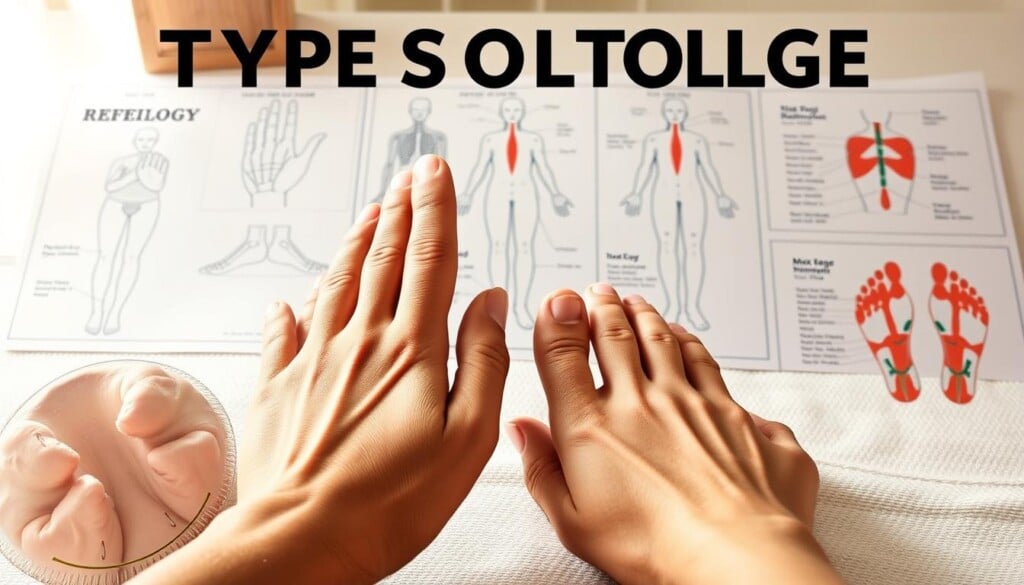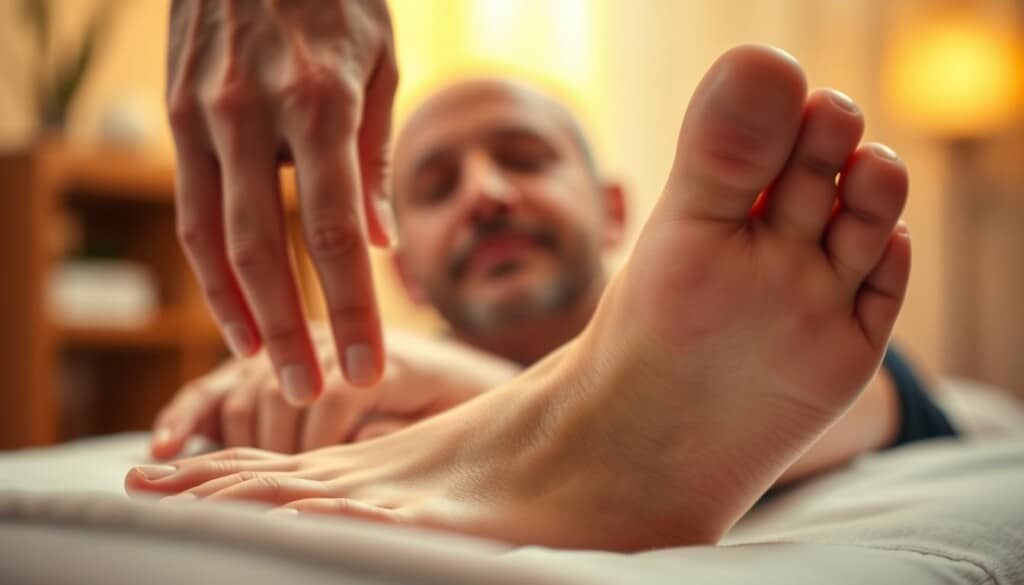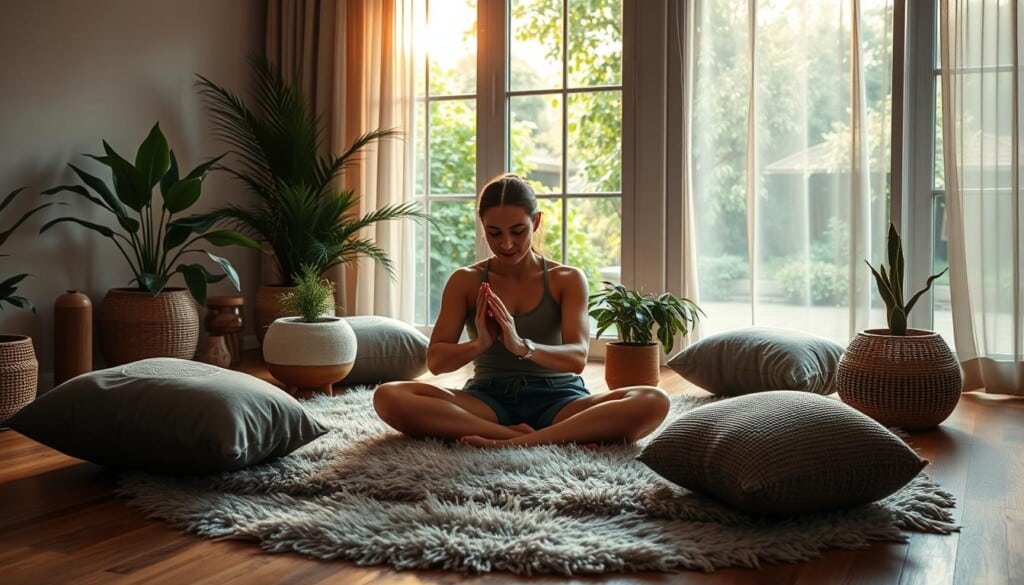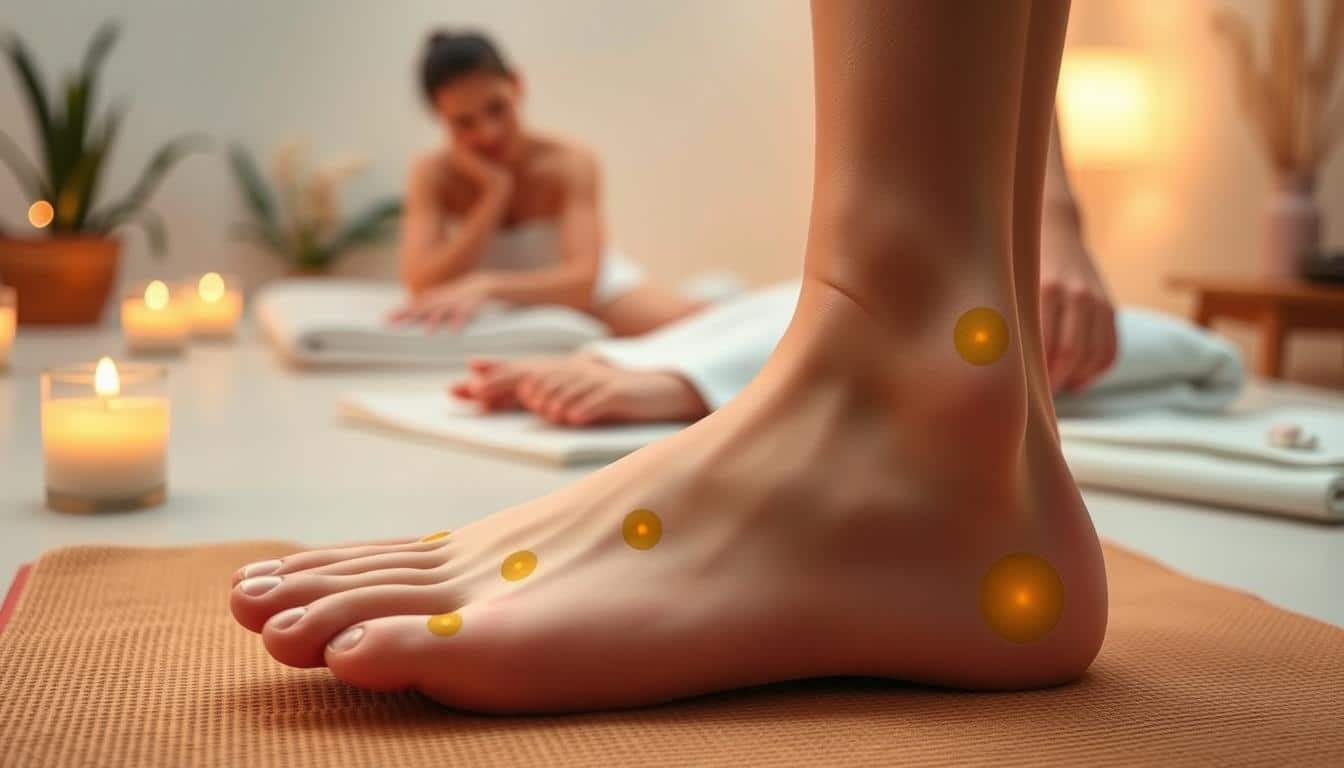Ever thought about how pressing points on your feet could boost your health? Reflexology, an old healing method, is now popular in wellness. It uses pressure points to improve your health and mood. This practice is gaining support from doctors as a helpful therapy.
In this article, we’ll explore the benefits and techniques of reflexology. It can make your wellness routine better.
Key Takeaways
- Reflexology is rooted in ancient practices but is becoming popular in modern healthcare.
- Specific pressure points correspond to different bodily organs and systems.
- Reflexology benefits encompass physical health improvements and mental well-being.
- Various reflexology techniques are employed to promote relaxation and pain relief.
- Medical professionals increasingly support reflexology as a complementary therapy.
What is Reflexology?
Reflexology is a therapy that uses pressure on the feet, hands, and ears. It’s based on the idea that these areas connect to different parts of the body. This gentle method helps the body heal itself and feel better overall.
Definition and Overview
Reflexology is a way to balance the body by applying pressure to specific points. It’s different from regular medicine because it focuses on relaxation and stress relief. This approach helps improve health without using invasive methods.
Historical Context
Reflexology has ancient roots, dating back to the Egyptians and Chinese. They used it in their holistic healing practices. In traditional Chinese medicine, it was key for treating both physical and mental health.
Modern Applications
Today, reflexology is used by many for stress relief and pain management. It’s also known for improving overall health. You can find reflexology services in your area by visiting this link.
How Reflexology Works
Reflexology is based on the idea that certain spots on the feet connect to different parts of the body. By pressing these spots, it’s thought to boost energy flow and help the body heal. Reflexology uses special techniques to tap into these connections, bringing benefits to those who receive it.
The Theory Behind Reflex Points
Reflex points are like a map for reflexologists, linking the feet to the body’s organs. Applying pressure to these points is believed to start the body’s healing process. It helps balance the body by improving circulation and easing tension, leading to better health.
Techniques Used in Reflexology
Reflexologists use thumb walking, finger pressure, and point rotation. These methods apply different levels of pressure to reflex points. The goal is to clear energy blockages, improve circulation, reduce stress, and ease pain. This approach helps people feel more relaxed and improves their health.
Benefits of Reflexology
Reflexology offers many benefits for both physical health and mental well-being. It focuses on specific points on the feet, hands, and ears. This helps to balance the body and improve health in many ways.
Physical Health Improvements
Reflexology can help with chronic pain, improve digestion, and boost circulation. Studies show it can reduce pain in up to 31% of cases. It’s also effective for back pain and headaches, making it a good choice for physical health.
Mental and Emotional Well-being
Reflexology helps with anxiety and depression. The calm setting of sessions helps people relax and clear their minds. It promotes emotional stability and helps build self-awareness and resilience.
Stress Reduction and Relaxation
Reflexology’s stress reduction techniques lead to deep relaxation. This boosts natural healing and overall well-being. Many people find it helps them manage stress better, leading to a more balanced life.
Different Types of Reflexology
Reflexology has many types, each focusing on different body areas for health. Foot reflexology is well-known, using special techniques on the feet. Hand and ear reflexology also exist, focusing on hands and ears. Each type offers unique benefits for different health needs.
Foot Reflexology
Foot reflexology uses pressure on the feet to help the body. It aims to ease pain, improve blood flow, and aid healing. Practitioners use a map to target specific areas for treatment.
Hand Reflexology
Hand reflexology works like foot reflexology but on the hands. It helps with health issues and relaxation. Its portability makes it great for quick relief anywhere.
Ear Reflexology
Ear reflexology is less common but beneficial. It stimulates points in the ears linked to body systems. Though not as famous as foot or hand reflexology, it helps balance and well-being.

Who Can Benefit from Reflexology?
Reflexology is a helpful therapy for many people. It offers targeted relief and boosts overall well-being. It’s good for different lifestyles and health issues, making it useful for lots of folks.
Athletes
Reflexology is key for athletes to recover better and perform better. It helps ease muscle tension and improves blood flow. This means athletes can get back in shape faster and perform better.
Pregnant Women
Reflexology helps pregnant women feel better by easing symptoms like nausea and anxiety. It makes pregnancy more comfortable and relaxing. It’s a safe, gentle way to care for expectant mothers, improving their physical and emotional health.
Individuals with Chronic Conditions
Reflexology helps those with chronic conditions like diabetes, multiple sclerosis, and fibromyalgia. It targets specific symptoms, reducing pain and improving life quality. Reflexology gives those with chronic conditions relief and a sense of control over their health.
Common Techniques Used in Reflexology
Reflexology uses special techniques to help heal and relax. Knowing these techniques makes the practitioner better and the client happier. Three main techniques are key to reflexology.
Thumb Walking
Thumb walking in reflexology means the practitioner uses their thumb to apply pressure. This pressure follows a path, like walking, to target reflex points. These points are linked to different body parts. Doing this right can really help clients get the benefits they want.
Finger Pressure
Finger pressure is similar to thumb walking but uses fingers. It lets practitioners work on smaller areas or specific points. This technique makes the session more effective and allows for detailed work.
Massage Techniques
Reflexology also uses different massage techniques like rotations, tapping, and kneading. These add to thumb walking and finger pressure, making the experience better. Each method helps to wake up the reflex zones, bringing more relaxation and healing to clients.

Reflexology Sessions: What to Expect
Knowing what to expect from reflexology makes the experience better. To prepare, you don’t need much. It’s best to eat lightly before, so you’re comfortable during the session. Wearing loose clothes also helps you relax.
Before Your Session
Getting ready for reflexology is easy. Think about what makes you comfortable and any areas you want to focus on. Letting the reflexologist know helps them tailor the session just for you.
During the Session
During reflexology, you’ll be in a peaceful setting. The reflexologist will use different methods. These methods work on special points on your feet, hands, or ears to help you relax and feel better.
Aftercare Recommendations
After reflexology, it’s important to take care of yourself. You might feel a bit tired or emotional. Drinking water and resting helps your body heal.
Integrating Reflexology into Your Wellness Routine
Adding reflexology to your wellness routine can boost your health and mood. How often you get reflexology depends on your needs. It’s usually once a week to once a month.
Frequency of Sessions
The right time for reflexology depends on your health goals and lifestyle. Getting it regularly helps reduce stress and improve health. A regular schedule keeps your body in balance and promotes health.
Combining Reflexology with Other Therapies
Using reflexology with other treatments like massage or acupuncture can make it more effective. This mix targets different health areas. It gives you a personalized approach to wellness.
At-Home Reflexology Techniques
If you want to try reflexology at home, self-massage and pressure points are good places to start. Doing reflexology at home helps you stay on top of your wellness. Simple steps can lead to big relaxation and pain relief benefits.

Finding Local Reflexology Services
Looking for local reflexology services is now easier with tools like the LocalZ directory. This platform is a great resource for finding therapies close to you. Just search for “finding reflexology near me” to find nearby practitioners.
Utilizing LocalZ for Business Listings
The LocalZ directory has the latest listings for local reflexology services. You can check out different therapists, their qualifications, and what they offer. This helps you make a smart choice for your reflexology needs.
How to Read and Compare Reviews
Reviews are key when choosing reflexology services. Look for feedback on client satisfaction, treatment success, and the therapist’s professionalism. This way, you get a clear idea of what to expect from sessions.
Booking Appointments Easily
After finding the right provider, booking appointments is easy on the LocalZ platform. This makes it simple to find therapy that fits your schedule. It helps you connect with local services and improves your well-being.
LocalZ: Connecting Local Communities
LocalZ is a platform that connects local businesses with their communities. It aims to make wellness services, like reflexology, more visible and accessible. Users can find qualified reflexology providers and build stronger community ties.
Overview of LocalZ Services
LocalZ offers tools to find health and wellness services easily. Users can browse listings to find services that meet their needs. The platform makes it simple to find reflexology experts close by.
Partnering with Local Reflexology Experts
LocalZ focuses on partnerships with local reflexology experts. This connection helps clients find the right services and promotes a holistic view of health. It also raises awareness of reflexology’s benefits in the community.
Supporting Local Organizations
LocalZ supports local reflexology through community efforts. It gives 50% of its annual fees to local organizations. This helps fundraise and boosts health and wellness initiatives in the community.
Conclusion: Embracing Reflexology for Health and Community
Reflexology is great for improving health and well-being. It helps with pain, relaxation, and stress. Adding reflexology to your routine can make you feel better physically and emotionally.
Local reflexology services are key to community health. They help keep health resources strong. By using directories like LocalZ, you can find the right reflexologist for you.
Using reflexology daily is good for you and your community. It helps small businesses thrive. Now is the time to try reflexology and support local providers for a healthier community.

